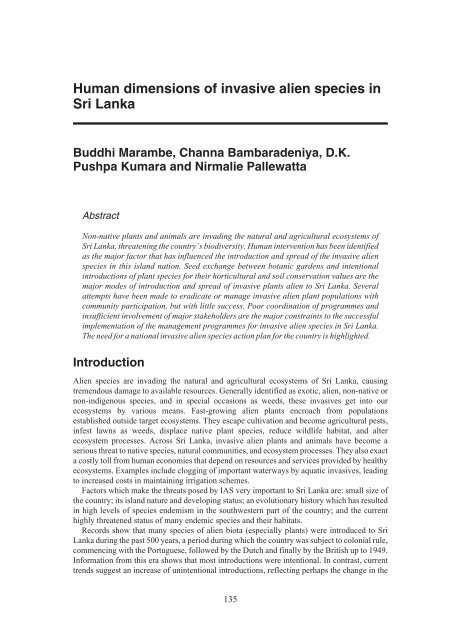Alien Species.vp - IUCN
Alien Species.vp - IUCN
Alien Species.vp - IUCN
You also want an ePaper? Increase the reach of your titles
YUMPU automatically turns print PDFs into web optimized ePapers that Google loves.
Human dimensions of invasive alien species in<br />
Sri Lanka<br />
Buddhi Marambe, Channa Bambaradeniya, D.K.<br />
Pushpa Kumara and Nirmalie Pallewatta<br />
Abstract<br />
Non-native plants and animals are invading the natural and agricultural ecosystems of<br />
Sri Lanka, threatening the country’s biodiversity. Human intervention has been identified<br />
as the major factor that has influenced the introduction and spread of the invasive alien<br />
species in this island nation. Seed exchange between botanic gardens and intentional<br />
introductions of plant species for their horticultural and soil conservation values are the<br />
major modes of introduction and spread of invasive plants alien to Sri Lanka. Several<br />
attempts have been made to eradicate or manage invasive alien plant populations with<br />
community participation, but with little success. Poor coordination of programmes and<br />
insufficient involvement of major stakeholders are the major constraints to the successful<br />
implementation of the management programmes for invasive alien species in Sri Lanka.<br />
The need for a national invasive alien species action plan for the country is highlighted.<br />
Introduction<br />
<strong>Alien</strong> species are invading the natural and agricultural ecosystems of Sri Lanka, causing<br />
tremendous damage to available resources. Generally identified as exotic, alien, non-native or<br />
non-indigenous species, and in special occasions as weeds, these invasives get into our<br />
ecosystems by various means. Fast-growing alien plants encroach from populations<br />
established outside target ecosystems. They escape cultivation and become agricultural pests,<br />
infest lawns as weeds, displace native plant species, reduce wildlife habitat, and alter<br />
ecosystem processes. Across Sri Lanka, invasive alien plants and animals have become a<br />
serious threat to native species, natural communities, and ecosystem processes. They also exact<br />
a costly toll from human economies that depend on resources and services provided by healthy<br />
ecosystems. Examples include clogging of important waterways by aquatic invasives, leading<br />
to increased costs in maintaining irrigation schemes.<br />
Factors which make the threats posed by IAS very important to Sri Lanka are: small size of<br />
the country; its island nature and developing status; an evolutionary history which has resulted<br />
in high levels of species endemism in the southwestern part of the country; and the current<br />
highly threatened status of many endemic species and their habitats.<br />
Records show that many species of alien biota (especially plants) were introduced to Sri<br />
Lanka during the past 500 years, a period during which the country was subject to colonial rule,<br />
commencing with the Portuguese, followed by the Dutch and finally by the British up to 1949.<br />
Information from this era shows that most introductions were intentional. In contrast, current<br />
trends suggest an increase of unintentional introductions, reflecting perhaps the change in the<br />
135












